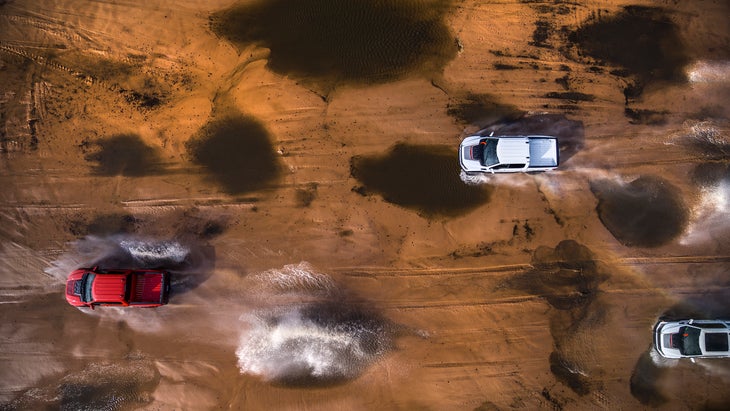I just drove the fastest internal combustion engine off-road truck that will ever be sold in a showroom. Packing 700 horsepower into the Ford Raptor R, and doing it so seamlessly that the vehicle never feels like it’s getting out of control, is an incredible achievement. But there’s already something faster and more exciting out there. It just isn’t powered by dead dinosaurs.
To be clear: Ford hasn’t said that the 2023 Raptor R will be the last internal combustion engine (ICE) Raptor. The company has a hard policy of not commenting on future product. It has stated publicly that electric vehicles will account for 40 percent of its entire production volume by 2030. That $22 billion transition is already underway and changing the very structure of the company itself. Ford announced in March that it’s splitting into two divisions: one focused on technology and growth, the other focused on generating short-term cash. Profits from the latter will help pay for the former. You can guess which one is responsible for the EVs.
Ford’s transition has already resulted in an electric pickup. In fact, that electric pickup shares its frame with this Raptor R. And it’s quicker. MotorTrend pegs the 0 to 60 time of the fastest Ford F-150 Lightning at just 3.8 seconds. No one’s performed instrumented, independent performance tests on the Raptor R yet, but initial estimates peg its time at around 4.5 seconds.
But the Lightning isn’t really intended for off-roading. It’s a practical, hard-working, relatively green pickup that asks everyday truck buyers to make few compromises in the pursuit of reduced emissions. The point of the Raptor R isn’t to perform work; it’s to create thrills. It’s the ultimate expression of truck as toy.
Creating the Raptor R was fairly simple. My friend David Tracy describes the finer points of what it took to do this over at his blog, The Autopian, but Ford basically took the supercharged V8 out of its fastest Shelby Mustang and stuck it in the existing non-R Raptor chassis. After three generations and 13 years, this finally gives the Raptor the power it needs to exploit its incredible suspension system. The result is simply more speed over open off-road terrain, like the sand dunes you’re looking at in these pictures, than any other ICE truck ever—at least one that you can put on a finance payment plan and that comes with a warranty. It starts at about $110,000, and during my time behind the wheel, returned about 10.5 miles per gallon both on-road and off.
Why would anyone ever pay that much money for a toy? Because they love the thrill of driving fast off-road. I’m one of those people. I like fast cars and trucks enough that I dropped out of college to make them the focus of my first career back in 2002, reviewing them for car magazines. But I also get why a lot of people find trucks like these so problematic. Eight years ago I quit my gig writing about vehicles to start writing about the outdoors. And like anyone else, I can see the damage the unfurling climate disaster is already wreaking on the natural world. In my lifetime, I’ll likely see the collapse of animal populations and the disappearance of glaciers from the mountains I like to climb and hike. The forests where I camp may burn down, and rivers where I fish may dry up. If we’re to preserve the ability for this planet to support future generations of humans at all, then all of us must work to be a part of a solution.
From the perspective of an outdoorsperson, I hope this really is the last internal combustion engine super truck. The crazy thing is, from the perspective of a truck enthusiast, I also really hope this is the last dinosaur-powered super truck.

Back in April, I drove the new 1,000 horsepower GMC Hummer EV. There are a lot of dry, analytical metrics by which you can judge the performance of a vehicle, on-road and off, and I’m sure my former colleagues at those car magazines will be conducting those tests soon. But what I can tell you right now is that people who buy fast super trucks aren’t doing it because there’s a tenth of a second difference to be found between one or another; they’re doing it for the thrill they’re capable of creating.
Take a full-speed acceleration run on either vehicle, for instance. Lift off the brake and stomp on the gas in the Raptor R, and you’ll be greeted by a lot of wheelspin, a little bit of sideways action, then some pretty impressive acceleration for such a big truck. Ford’s engineers are proud of the work they’ve put into making this third-generation Raptor chassis better able to put that power down on off-road surfaces, but the new five-link rear end still hops and chatters over rough surfaces, and ultimately fails to allow you to take full advantage of that supercharged V8. Doing the same thing in the Hummer EV dropped my stomach and blurred my vision. The feeling of acceleration was so intense that this former professional vehicle tester wasn’t even able to make it all the way to 60 miles per hour before lifting off the throttle. The $112,500 Hummer EV is not without its issues, but it’s proof that an EV can be fast, wild, scary, and impressive to drive, too.

So I think the Ford Raptor R is going to be the last of the ICE super trucks simply because it has to be. Burning fossil fuels no longer delivers more off-road thrills than unleashing a whole lot of electrons. And maybe, just maybe, this marks a small win: hope that trucks like these can continue to exist on a planet capable of supporting human life.
Credit: Source link































